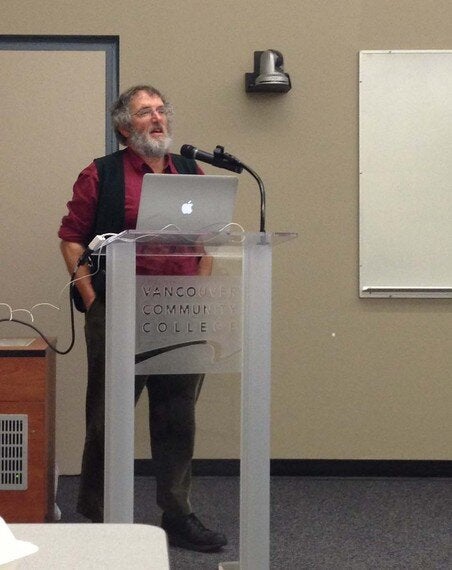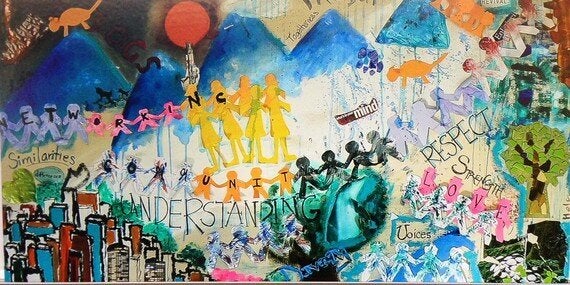I caught myself staring at the mountains the other day. As someone who recently moved from the concrete jungle of a big city, Vancouver is a startling place to end up in, as you're surrounded by relentless natural beauty. However, I soon discovered that this is juxtaposed against stark issues of housing affordability and homelessness. It was therefore fitting that beauty and the arts was the topic of several talks during Homelessness Action Week (HAW) which took place throughout Metro Vancouver from October 13th to 19th. In his talk, Beauty and the City Beast, Prof. Trevor Hancock discussed the need for beauty in our urban lives, and especially in the lives of the homeless. Beauty "pleases the eye, lifts the spirit, and soothes the soul" and he argues that it should form a more vital and integral part of our lives.

Professor Trevor Hancock is a public health physician and health promotion consultant and is currently a professor and senior scholar at the new School of Public Health and Social Policy at the University of Victoria
The other speakers at HAW that echoed this point included Molly McDonald from the Mental Patients' Association (MPA) Society, Nicki Kahnamoui of the Arts Health Network of BC, and Leef Evans, an artist who was formerly homeless. These speakers attested to the health and emotional benefits that active engagement in the arts can have.
Many people think of the homeless purely as those who are unsheltered, the people you see sleeping on the streets; however, those who stay in emergency shelters, provisional housing and those at risk of losing housing make up the full spectrum of homelessness. In Vancouver, the homeless population numbered approximately 1600 individuals while the Metro Vancouver area found approximately 2,650 homeless in their 2011 count (both reports stated that these are undercounts). Although there have been significant increases in the number of sheltered individuals (an increase of 74% in the Metro Vancouver area from 2008 to 2011 and 72% in Vancouver from 2005 to 2013) the counts revealed that there is an increase in mental illness, multiple health conditions, and addiction among the homeless.
As humble as they might be, beauty and art can play a part in the support service toolkit that helps the homeless with life challenges and provides assistance that is emotional, social, and spiritual in nature. Prof. Hancock showed the audience several examples of how beauty, in the form of art and nature, conferred health benefits to the sick. In one study, hospital patients were divided into two groups, one with windows facing nature and the other with windows onto a blank, brick wall. Those patients who had views onto nature showed faster recovery times and more positive attitudes in comparison to those who did not. Another study found that people in waiting rooms who were in the presence of landscape art showed a reduction in restless behaviour and fewer queries made at the front desk, and increased socialization.
Over and above the act of observing art, people who participate in the arts reap benefits that spill over into their daily lives. Executive director of Arts Health Network, Nicki Kahnamoui showed us that people who attended cultural festivals, listened to music, and read books reportedly felt more healthy, were more connected to their neighbours, and had greater satisfaction with life. The benefits from passive appreciation of art by looking or listening, are thus amplified with more active engagement with the arts.
The arts also has a way of capturing and expressing the experiences of the homeless and marginalized groups which provide insight into their daily lives. Students from Vancouver's Lord Byng Secondary got to experience this first-hand. Almost 50 students participated in a HAW-sponsored program where they collaborated with the homeless to create large 6'x 4' paintings. The students were put into groups with homeless individuals from the MPA society and together they built their canvas, sketched out the composition, and painted. By taking the focus off socio-economic differences and placing it on the art itself, the students eventually humanized the homeless. "By interacting with the MPA Members, I realize that they are just like other people, but have fallen on hard times," said one student. Another commented, "Their lives had not always been so challenging, and that mental illness and homelessness can affect literally anyone."
The time and interactions between students and MPA members broke down stereotypes of what a homeless person looked like, how they behaved, their life history, and education levels. One of the students was surprised to find that an MPA society participant was actually a waitress at a restaurant her family regularly went to. The communal experience of observing art or creating it can form bonds, nurture understanding and build stronger communities.

Finished painting by MPA Society members and Lord Byng students
As Vincent Van Gogh, my 7-year-old niece or any prolific artist can tell you, art provides an outlet for emotions and helps you make sense of the world. The health and emotional benefits of the arts are especially important to homeless communities, as they are the "building blocks that help individuals move forward," says Nicki Kahnamoui. "Engagement in creative activity helps with motivation, communication, self-expression, [and it] lowers stress." Kahnamoui believes this can translate to tangible improvements in their quality of life. "You've now got someone who can express themselves. As they express themselves better, they get heard, they are less likely to get angry, they are able to communicate with other people. When they have better self-confidence, they are more likely to hold on to the housing they have, they are more likely to go out there and gain some new skills."
But art proponents would hesitate in stating that engagement in the arts can alter more systemic problems. "What I'm not going to do is in any way suggest that art is going to address the problem of homelessness, it's not," acknowledges Kahnamoui. "But there is a link between all these projects, and the people who engage in creative activity they feel motivated, they feel inspired, they communicate, they express themselves and slowly they make transformations."
As a recent report on homelessness showed, it is a combination of housing, income and supports that will ensure that low-income populations can be housed sustainably. Leef Evans was a prime example of someone who found security in housing, who then used art as a form of therapy and to provide meaning to his life. His vibrant, multi-media work was exhibited at the Out of the Rain art gala and auction, that closed out Homelessness Action Week (link). "I made art when I found housing. When I felt stable, comfortable and safe enough that I could go out and do work, make significant strides and do the things that I wanted to do."

(left to right) Vancouver planner Valerie Durant, MPA Society's Molly McDonald, artist Leef Evans and Arts Health Network's Nicki Kahnamoui.
Yet despite all the benefits the arts offers us, we have made it a luxury item and something practiced only by experts. Kahnamoui believed that the arts needs to become everybody's right and should be accessible to all. Similarly, Hancock thought that art is a rather mundane act that is much more accessible than we currently think of it: "Too often art, dance, song, whatever it may be is done by experts [and] experts classify this stuff. But if you can walk, you can dance. You put one foot in front of the other. ...We have to sort of let go of our inhibitions, I really like that notion."
If you weren't able to attend the events at Homelessness Action Week, the spirit of art and community continue at the Heart of the City Festival dedicated to showcasing and nurturing art in the Downtown East Side which runs from October 23rd to November 3th. Author's disclaimer here: engagement in the arts may make you healthier, happier, and more satisfied with life.
PHOTOS: IMELDA NURWISAH